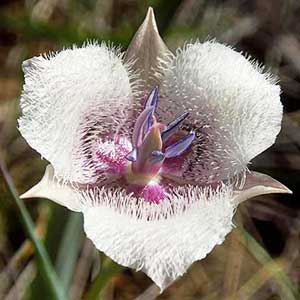|
hairy star tulip, pussy ears, Tolmie star-tulip, Tolmie's cat's ear, Tolmie's mariposa-lily
|
Inyo County star-tulip
|
± slender, usually branching, 1–4 dm. |
slender, not branching, 1–3 dm. |
basal persistent, 1–4 dm; blade lanceolate, tapering at base, flat; cauline bractlike. |
basal usually persistent, 1–2 dm; blade linear. |
± umbellate, 1–several-flowered. |
subumbellate, 1–4-flowered; bracts paired, 3–8 cm. |
erect or spreading; perianth open, campanulate; sepals 10–15 mm; petals white to pinkish or purplish, obovate, 12–25 mm, adaxial surface densely hairy, margins ciliate; glands bordered proximally by ciliate membrane, distally by short hairs; anthers lanceolate, apex acute to apiculate. |
erect; perianth open, campanulate; sepals lanceolate, 2–3 cm, apex acuminate; petals lavender, with longitudinal median abaxial green stripe, with or without blotches, broadly cuneate to obovate, 3–4 cm, with a few short hairs near gland; glands round, depressed, surrounded by conspicuously fringed membrane, densely covered with short, distally branching hairs; filaments 6–8 mm; anthers red-brown, oblong, 7–10 mm, apex obtuse. |
nodding, winged, oblong, 2–3 cm. |
erect, brown, lanceoloid-linear, 3-angled, 2–3 cm. |
deep purple, dark brown in age, irregular. |
light beige, translucent, flat. |
= 20. |
|
|
|
|
|
| Flowering mid spring–mid summer. |
Flowering spring. |
| Open grassy slopes or in woods, often on poor, dry soil |
Grassy meadows in shadscale scrub |
| 0–2000 m (0–6600 ft) |
1200–2000 m (3900–6600 ft) |
|
CA; OR; WA
|
CA |
|
Calochortus excavatus is found only in the eastern Sierra Nevada in Mono and Inyo counties. It is threatened by groundwater depletion. (Discussion copyrighted by Flora of North America; reprinted with permission.) |
| FNA vol. 26, p. 124. |
FNA vol. 26, p. 137. |
| Liliaceae > Calochortus |
Liliaceae > Calochortus |
C. albus, C. amabilis, C. ambiguus, C. amoenus, C. apiculatus, C. argillosus, C. aureus, C. bruneaunis, C. catalinae, C. clavatus, C. coeruleus, C. concolor, C. coxii, C. dunnii, C. elegans, C. eurycarpus, C. excavatus, C. flexuosus, C. greenei, C. gunnisonii, C. howellii, C. indecorus, C. invenustus, C. kennedyi, C. leichtlinii, C. longebarbatus, C. luteus, C. lyallii, C. macrocarpus, C. minimus, C. monanthus, C. monophyllus, C. nitidus, C. nudus, C. nuttallii, C. obispoensis, C. palmeri, C. panamintensis, C. persistens, C. plummerae, C. pulchellus, C. raichei, C. simulans, C. splendens, C. striatus, C. subalpinus, C. superbus, C. tiburonensis, C. umbellatus, C. umpquaensis, C. uniflorus, C. venustus, C. vestae, C. weedii, C. westonii |
C. albus, C. amabilis, C. ambiguus, C. amoenus, C. apiculatus, C. argillosus, C. aureus, C. bruneaunis, C. catalinae, C. clavatus, C. coeruleus, C. concolor, C. coxii, C. dunnii, C. elegans, C. eurycarpus, C. flexuosus, C. greenei, C. gunnisonii, C. howellii, C. indecorus, C. invenustus, C. kennedyi, C. leichtlinii, C. longebarbatus, C. luteus, C. lyallii, C. macrocarpus, C. minimus, C. monanthus, C. monophyllus, C. nitidus, C. nudus, C. nuttallii, C. obispoensis, C. palmeri, C. panamintensis, C. persistens, C. plummerae, C. pulchellus, C. raichei, C. simulans, C. splendens, C. striatus, C. subalpinus, C. superbus, C. tiburonensis, C. tolmiei, C. umbellatus, C. umpquaensis, C. uniflorus, C. venustus, C. vestae, C. weedii, C. westonii |
| Hooker & Arnott: Bot. Beechey Voy., 398. (1840) |
Greene: Pittonia 2: 71. (1890) |
| |
